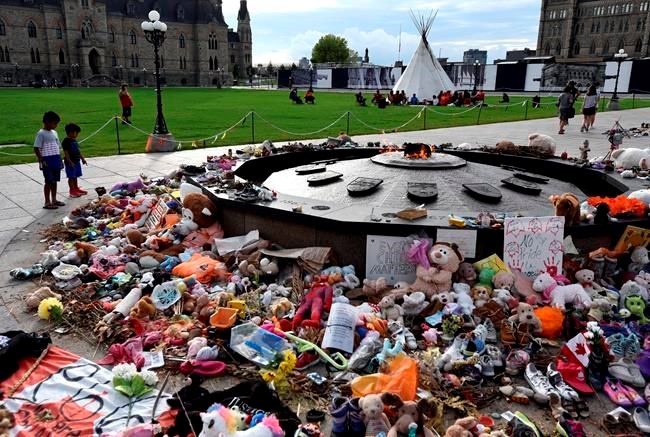Ottawa is eyeing a possible five-year timeline to build a national monument to honour children who suffered its residential school system.
Construction of a memorial in the national capital was listed as one of the calls to action in the final report from the Truth and Reconciliation Commission of Canada.
It collected testimony from thousands of Indigenous people forced to attend church-run, government-funded institutions as children. They were separated from their families, stripped of their culture and suffered various forms of abuse.
The National Centre for Truth and Reconciliation, which holds residential school-related records, recently issued a call to survivors and their children, saying the federal Canadian Heritage Department seeks applicants to be part of a steering committee to guide creation of a monument.
The post says the survivor-led committee would "provide guidance and oversight on the monument project from its initial planning phase through its completion," which would be a five-year process.
A spokesman for Canadian Heritage said it's too early to state exact timelines on the project, adding only that once a steering committee is nominated, an official announcement would be made.
The call for Ottawa to build a national monument honouring residential school attendees was included in the Truth and Reconciliation Commission's final report in December 2015.
A day-and-a-half workshop regarding the project was held in 2019 with survivors and others from the commission, including former commissioner Marie Wilson, who was asked to lead the group.
Wilson says "the response to everything has been far too slow."
"Urgency is one measure of respect," she told The Canadian Press in a recent interview.
"When you have aging survivors who are passing every day, that's one more survivor who will never see a national monument to the extent that that is one of their legacies."
It wasn't until last August that the federal government dedicated funding to the memorial. It pledged $20 million after First Nations in Saskatchewan and British Columbia discovered unmarked graves at the former sites of residential schools, which touched off a countrywide reckoning about how Canada treats Indigenous children.
Yellowhead Institute researcher Eva Jewell, who helps track progress on the commission's calls to action, says it was unfortunate survivors and others didn't have a dedicated place to go to mourn after news of the unmarked graves emerged.
Instead, people laid hundreds of tiny shoes, teddy bears and flowers at public sites across Canada, including the Centennial Flame on Parliament Hill. The Hill memorial was eventually dismantled last October and its items remain in storageafter officials worked for weeks on how to respectfully move them.
While Jewell welcomes the formation of a survivors' circle, she says the lack of an existing monument speaks to "the continuing reactionary nature of reconciliation."
Wilson saysover its lifetime the commission heard regularly from people who knew nothing of the residential schools, which is why commemoration was prioritized. She also pointed to the shock people expressed following the discoveries of unmarked graves as an example of the work still needed to broaden understanding.
One way the national monument has been discussed, Wilson says, is as a means for survivors to keep talking after they are gone. It would also demonstrate that Canada is "courageous enough to face up to its own history," she added, and serve as a place for healing and learning.
"What the workshop talked about, I think, in a very beautiful and comprehensive way, is that such a national monument, among other things, can serve the role of the kind of symbolic burial site for the unknown child ... just as we have one for the (Tomb of the) Unknown Soldier," said Wilson.
"There are some children who will never be found."
This report by The Canadian Press was first published March 30, 2022.
Stephanie Taylor, The Canadian Press




